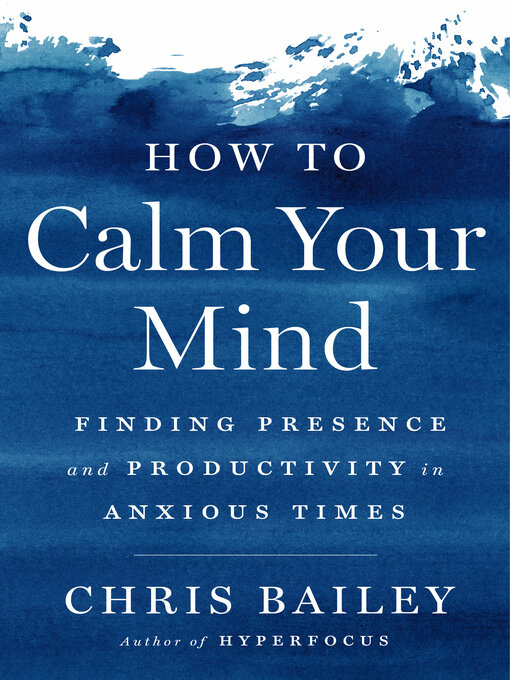“After rebounding from his own burnout, Bailey devised a clear-eyed, concise method that marries science and self-help; he’s equally proficient in probing the roles of serotonin and endorphins while charting concrete steps in chapters titled ‘The Mindset of More’ and ‘Heights of Stimulation.’ Slow down, breathe, and submerge into these pages.” —Oprah Daily
A PENGUIN LIFE BOOK
It took an on-stage panic attack for productivity expert Chris Bailey to recognize how critical it is to invest in calm at the same time that we invest in becoming more productive. Productivity advice works—and we need it now more than ever—but it’s just as vital that we develop our capacity for calm. By finding calm and overcoming anxiety, we don’t just feel more comfortable in our own mind—we build a deeper, more expansive reservoir of energy to draw from throughout the day. The pursuit of calm ultimately leads us to become more engaged, focused, and deliberate—while making us more satisfied with our lives. And because calm saves us time by making us more productive, we don’t even need to feel guilty about the time we spend investing in it.
How to Calm Your Mind is our crucial guide to achieving calm, navigating anxiety, and staving off burnout. It explains how our digital world drains us, and what we can do to abate the hidden sources of stress that burden our days. Bailey has learned to embrace the analog world and “stimulation fasts,” to use the science of “savoring” to become more focused and present, and to relax without guilt—and he shows us how we can reclaim calm, too. In an anxious world, investing in calm might be the best productivity strategy around.
-
Creators
-
Publisher
-
Release date
December 27, 2022 -
Formats
-
Kindle Book
-
OverDrive Read
- ISBN: 9780593298527
-
EPUB ebook
- ISBN: 9780593298527
- File size: 2686 KB
-
-
Languages
- English
-
Reviews
-
Publisher's Weekly
October 10, 2022
Productivity consultant Bailey (Hyperfocus) delivers a pragmatic guide to reducing stress. He recounts how experiencing a panic attack during a business presentation led him to search for strategies to fight burnout, contending that “investing in calm is the way to maintain and even grow our capacity for productivity.” Downtime, he posits, can lessen anxiety and helps to percolate new ideas and break the addiction to stress, which occurs when one becomes reliant on the stimulation provided by such sources of anxiety as negative news stories. He recommends setting aside time each day to not worry about productivity and suggests taking up meditation, which lowers the level of dopamine that the body craves. Bailey is frank about the difficulty of seeking calmness and notes that self-care will likely cause guilt in readers who have an “accomplishment mindset,” but he adds that such busywork as refreshing one’s email can become mentally equated with accomplishment even though it’s more stress-inducing than productive. Instead, he urges readers to take breaks, exercise, and eat more complex carbohydrates, which all increase calmness and productivity. Bailey’s discussion of how dopamine and serotonin influence feelings of productivity brings scientific rigor to his observations, which are sensible and occasionally counterintuitive. This practical manual is worth slowing down for. -
Library Journal
December 16, 2022
Bailey, a productivity expert and author who also hosts a podcast, shows how balancing efficient productivity practices with calm makes for better results in everyday life. This is his personal journey to calm, and he relates how anxiety from his career led to his need for a change, and how natural that burnout can be for most of us. He guides readers through reasonable expectations for productivity and brings in the benefits of his "non-productive" calm time and how that helps achieve one's goals more effectively. He goes into the science of how different mindsets function and what triggers them, to better help readers understand and strategize using his ideas as a basis. He demonstrates how smartphones are a big reason for a dopamine rush, with their push notifications and YouTube videos and 24-hour news cycle, which make one want to consume more, and he offers ideas for how to balance out or eliminate dopamine-driven habits we've developed. VERDICT While occasionally repetitive, and while it could benefit from additional voices, this book makes for a good start on the journey to calm.
Copyright 2022 Library Journal, LLC Used with permission.
-
Booklist
December 16, 2022
Almost any book with ""calm"" in the title will attract readers in these chaotic times. When that book is authored by a productivity expert, the curiosity generated may prove irresistible. At least that is the case with How to Calm Your Mind by renowned productivity expert Bailey (Hyperfocus, 2018). On the heels of an on-stage panic attack, Bailey was shocked to realize that increases in productivity also mean better life balance and more free time. Readers learn that expectation is thwarted by the pervasive "accomplishment mindset" and the ties between digital engagement and dopamine demands from our brain. Packed with in-depth exploration of the causes of anxiety and the strategies that may provide relief and a calming of the mind, readers will find much to contemplate and apply within these pages. Strategies range from straightforward (prioritize sleep, reduce caffeine) to philosophical (redefine success, define positive boundaries), all of which are challenging and for Bailey were part of a years-long process. Recommended for public library collections.COPYRIGHT(2022) Booklist, ALL RIGHTS RESERVED.
-
Formats
- Kindle Book
- OverDrive Read
- EPUB ebook
subjects
Languages
- English
Loading
Why is availability limited?
×Availability can change throughout the month based on the library's budget. You can still place a hold on the title, and your hold will be automatically filled as soon as the title is available again.
The Kindle Book format for this title is not supported on:
×Read-along ebook
×The OverDrive Read format of this ebook has professional narration that plays while you read in your browser. Learn more here.



